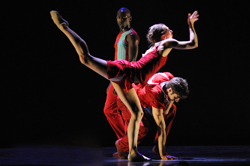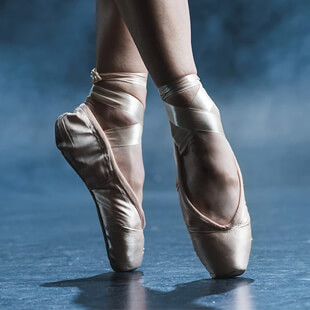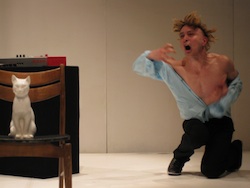Jocelyne Montpetit’s “Nuit_Nacht_Notte” moves at its own pace, harbouring the haunted, brooding sympathies associated with nocturnal apparitions and imaginings. The dancer-choreographer, renowned for her typically subtle emotions and assured control of mood, inscribes her work with precision and a delicate touch. In terms of physical presence, she approaches her choreography from an almost philosophic, metaphysical perspective, not to move just to move, but to probe the body and treat it as living matter on stage, resulting in a complex interconnectivity between presence, embodiment and performance.
Through her travels, crossing and re-crossing the Atlantic and Pacific, Montpetit’s influences incorporate a wealth of twentieth-century dance and movement practices. She studied with butoh masters Tatsumi Hijikata and Kazuo Ohno in Japan, who moved to an interior space. Her studies also include training in mime with Étienne Decroux in Paris and physical theatre with Gilles Maheu. Her work is in the lineage of their inspiration and traditions, but her performances are nothing if not an amalgam of styles and information. In many ways, she blunts her identity as a choreographer by not adhering to a particular style or innovation.
Reading Montpetit’s work has nothing to do with historic precedent or even a material dancing body. She’s working at transforming her body and gauging her presence, though her physical actions don’t often articulate what’s going on under the surface. Metamorphosis is key, a quality she learned from Hijikata (apparently as one of only two Westerners to train with the man who revolutionized the art of dance in Japan).
As I see it, Montpetit embodies “presence”. In terms of her relationship with her audience, we’re invited to witness imaginative journeys, where past, and present and future, seemingly inhabit the same stage, though narrative structure never exists in her work. She taps into memory, but it’s memory that she’s developed in her own mind’s eye, from which we’re excluded.
On stage, she gives herself over to the defined structure of a particular piece, composing a landscape, abandoning herself, pure and simple, in the process. In her interpretation, the solid body she has (the musculature of her back and arms are in evidence) figuratively evaporates, is without limits. She inhabits her “characters” in a quiet way, open to the lights, the sound, the substance of what exists for her in the work.
In this solo dance, she inhabits a space beautifully unified by Marc Parent’s lighting design, infused with dark shadows and twilight hues. Adding to the beguiling and mysterious atmosphere is the musical selection of Franz Schubert’s song sequence “Night and Dreams” (plus selections from Mahler and Bizet, among others). At the end of the piece, actor Francesco Capitano emerges from the shadows at the back of the stage (Montpetit is downstage centre). With his rich, sonorous voice, he recites passages from the nineteenth-century odes to the night of Portuguese poet Fernando Pessoa.
“Nuit_Nacht_Notte” is a tangled affair. At the top she uses the young rockabilly Elvis Presley singing “Are You Lonesome Tonight?” You can just imagine him, with a pompadour probably, in full swagger. Montpetit doesn’t replicate any of this: she reclines on the floor, slowly moving her legs, dressed in a form-fitting blue cocktail dress. Over an extended period of time, she simply supports herself, or otherwise leans into the floor. Her smartly coiffed straight hair hangs over her face like a veil. Where there’s electricity in the recording — you know that Presley’s sexuality and energy was both adored and feared — here the crowd that surrounds me is silent, reverential, some in slumber mode. For Montpetit, there’s no gyrating, no lip curls or smoldering grins. As expressed in her stance, languor is perhaps the key. It’s the kind of slowed down movement that can be traced to butoh. Or is it weariness, a foreshadowing of things to come? What is her reality?
When she eventually stands in a crouched position, there’s something almost ancient and reptilian about the way she holds herself. And in her party dress it’s downright odd. Presley’s song is long finished when she hunches her back, and merely hangs, weighted down in her carriage. Montpetit’s hand reaches up, but with her mane of hair still veiling her face, we never sense transcendence, a haunted suffering or a passion. Her expression never registers, and so she remains, in a sense, elusive.
I want to return to the Presley music, as Montpetit does herself. Curiously, she brings back Presley’s song, this time the version from 1977, when he was a bloated, sweaty superstar, decked out in gaudy studded jumpsuits. In the track you hear that he’s bored; he gulps, slurs, chortles and is plainly drugged out. Elvis’ nightmarish incarnation completely blurs the romantic ballad. It’s pure pop kitsch horror, but Montpetit doesn’t seem to know what to do with the music she’s chosen. The selection is not a brazen act in a nod to butoh. Perhaps she is indeed in an altered state, as there’s no transition into a different physical texture from the previous section — her mouth is still agape, the pulse of her movement at barely a beat, sometimes only a twitch of a finger or the shift of a leg, and she remains impenetrable to the public. Ultimately, in this sequence, she is undone in part by her physical body, because in the here and now she is not a spirit or an essence, and her concreteness is ever-present.
When she disrobes for the first time, she revives a coveted red dress from a previous work, “Lettres à un homme russe”, performed at a much earlier phase of her career. She flirts with eroticism, but her nudity is sculptural, with an inherent fineness. Topless, and in briefs, she clutches and hoists the dress, and it serves as her partner. At one point, the dress seems to hesitate, and she masterfully and uncannily imbues the costume with something that feels deep and alive. (Montpetit clearly loves her costumes, and she wears them with élan. Her final costume is a long, white, almost diaphanous dress.)
Montpetit doesn’t present tragic force, nor in her embrace of the flatulent Presley is there any sense of self-parody or exploitation of his vulgarity. Her surrender is delivered in a flat-line, albeit one that, thanks to the lighting in particular, is very beautifully packaged in a very decided way. There is no sense of excitement, of danger in her presence. She is not a performer who delights in her own finesse, nor does she possess an intensity that can stir an intense reaction in the watching crowd. No humour, no danger, she’s just there. Although it’s easy to admire the rigour of her work, and her integrity can’t be faulted, there’s little way in. Her incarnations suggest the exploratory. When she’s on stage, however, I’m all too aware that there are built-in contradictions in her broadly defined “presence”. When she submerges herself in her role, the dance dies before us. Echoing these poetic spheres of disappearance, ephemerality and beauty, is the lush, moody quality of Montpetit’s sketches. And bestowed with an ability to incarnate an inner state, it’s important to point out that she never literalizes the meaning and mood of the music or texts she incorporates into the dance.
I’m ambivalent about this work, perhaps because it references forms such as butoh yet lacks its intensity, and so never wholly seizes our attention. The thing is, Montpetit never commands the stage. That doesn’t seem within her grasp, or her interest. I’m not sure which. However, all of the layering, whether through her gorgeous dresses, the entrancing lights or the thrilling Schubert songs, left me with a sense of beauty and grace — and that, I suppose, is nothing to dismiss.
Tagged: Contemporary, Performance, Montréal , QC





